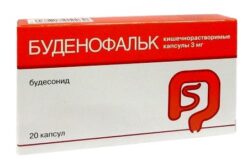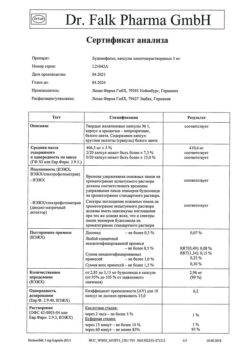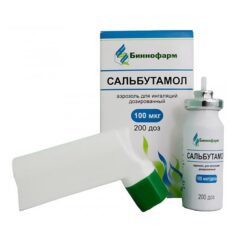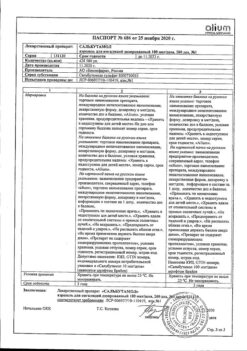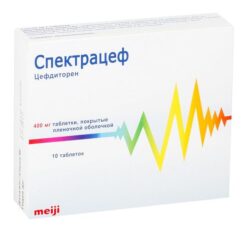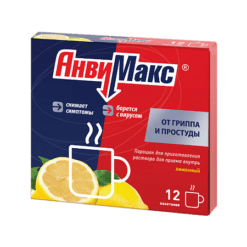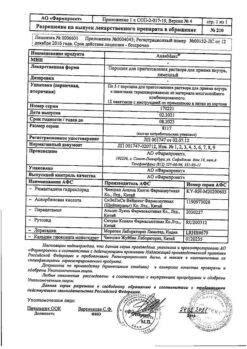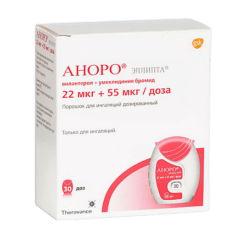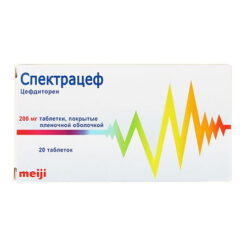No products in the cart.
Asthmasol-Solopharm, 0.25 mg/ml+0.5 mg/ml 20 ml
€6.02 €5.27
Description
Combined bronchodilator drug. It contains two components with bronchodilator activity: ipratropium bromide – m-cholinoblocker, and fenoterol hydrobromide – beta2-adrenomimetic.
Ipratropium bromide is a quaternary ammonium derivative with anticholinergic (parasympatholytic) properties. Bronchodilation during inhalation administration of ipratropium bromide is mainly due to local rather than systemic anticholinergic action. Ipratropium bromide inhibits vagus nerve reflexes by counteracting the effects of acetylcholine, a mediator released from the vagus nerve endings. Anticholinergic agents prevent the increased intracellular concentration of calcium ions that occurs due to the interaction of acetylcholine with muscarinic receptors located on bronchial smooth muscle. Calcium ion release is mediated by a system of secondary mediators, which include inositol triphosphate and diacylglycerol. Ipratropium bromide has no adverse effect on airway mucus secretion, mucociliary clearance, and gas exchange.
Phenoterol selectively stimulates β2-adrenoreceptors at the therapeutic dose. Stimulation of β1-adrenoreceptors occurs when fenoterol is used at high doses. Fenoterol relaxes the smooth muscles of the bronchi and vessels and counteracts the development of bronchospastic reactions due to the influence of histamine, methacholine, cold air and allergens (immediate-type hypersensitivity reactions). Immediately after administration, fenoterol blocks the release of mediators of inflammation and bronchoobstruction from mast cells. In addition, an increase in mucociliary clearance has been observed when using fenoterol in higher doses.
The effects of the drug on cardiac activity, such as increased heart rate and force, are due to the vascular action of fenoterol, the stimulation of β<2 adrenoreceptors of the heart and, when used in doses greater than therapeutic, by stimulation of β1 adrenoreceptors. As with other beta-adrenergic drugs, prolongation of the QT intervalc has been observed when used in high doses.
The most common adverse effect of β-adrenoreceptor agonists is tremor. In contrast to effects on bronchial smooth muscle tolerance may develop to systemic effects of β-adrenoreceptor agonists, but the clinical significance of this manifestation is not clear.
When using ipratropium bromide and fenoterol together, the bronchodilator effect is achieved by affecting different pharmacological targets. The mentioned substances complement each other, as a result the antispasmodic effect on the bronchial muscles increases and a wider therapeutic effect is achieved in case of bronchopulmonary diseases accompanied by airway obstruction. The complementary effect is such that a lower dose of the beta-adrenergic component is required to achieve the desired effect, which allows an individual selection of the effective dose with virtually no side effects.
In patients with bronchospasm associated with COPD (chronic bronchitis and pulmonary emphysema), a significant improvement in pulmonary function (increase in OEF1 and peak expiratory rate by 15% or more) was noted within 15 min, the maximum effect was achieved in 1-2 h and lasted in most patients until 6 h after administration.
Indications
Indications
Prevention and symptomatic treatment of obstructive airway diseases with reversible airway obstruction, such as bronchial asthma and, especially, COPD, chronic bronchitis with or without emphysema.
Pharmacological effect
Pharmacological effect
Combined bronchodilator drug. Contains two components with bronchodilator activity: ipratropium bromide – an m-anticholinergic blocker, and fenoterol hydrobromide – a beta2-adrenergic agonist.
Ipratropium bromide is a quaternary ammonium derivative with anticholinergic (parasympatholytic) properties. Bronchodilation with inhaled ipratropium bromide is due primarily to local rather than systemic anticholinergic effects. Ipratropium bromide inhibits reflexes caused by the vagus nerve by counteracting the effects of acetylcholine, a neurotransmitter released from the endings of the vagus nerve. Anticholinergics prevent an increase in the intracellular concentration of calcium ions, which occurs due to the interaction of acetylcholine with muscarinic receptors located on the smooth muscles of the bronchi. The release of calcium ions is mediated by a system of secondary mediators, which include inositol triphosphate and diacylglycerol. Ipratropium bromide does not have a negative effect on mucus secretion in the respiratory tract, mucociliary clearance and gas exchange.
Fenoterol selectively stimulates β2-adrenergic receptors at a therapeutic dose. Stimulation of β1-adrenergic receptors occurs when fenoterol is used in high doses. Fenoterol relaxes the smooth muscles of the bronchi and blood vessels and counteracts the development of bronchospastic reactions caused by the influence of histamine, methacholine, cold air and allergens (immediate hypersensitivity reactions). Immediately after administration, fenoterol blocks the release of mediators of inflammation and bronchial obstruction from mast cells. In addition, when using fenoterol in higher doses, an increase in mucociliary clearance was observed.
The effect of the drug on cardiac activity, such as an increase in the frequency and strength of heart contractions, is due to the vascular effect of fenoterol, stimulation of β2-adrenergic receptors of the heart, and when used in doses exceeding therapeutic doses, stimulation of β1-adrenergic receptors. As with other beta-adrenergic drugs, prolongation of the QTc interval has been observed when used in high doses.
The most common adverse effect with β-adrenergic agonists is tremor. In contrast to the effects on bronchial smooth muscle, tolerance to the systemic effects of β-adrenergic agonists may develop, but the clinical significance of this manifestation is unclear.
When ipratropium bromide and fenoterol are used together, the bronchodilator effect is achieved by acting on various pharmacological targets. These substances complement each other, as a result, the antispasmodic effect on the bronchial muscles is enhanced and a greater breadth of therapeutic action is provided for bronchopulmonary diseases accompanied by airway obstruction. The complementary effect is such that to achieve the desired effect, a lower dose of the beta-adrenergic component is required, which allows you to individually select an effective dose with virtually no side effects.
In patients with bronchospasm associated with COPD (chronic bronchitis and emphysema), a significant improvement in lung function (increase in FEV1 and peak expiratory flow by 15% or more) was noted within 15 minutes, the maximum effect was achieved after 1-2 hours and lasted in most patients up to 6 hours after administration.
Special instructions
Special instructions
The patient should be informed that if shortness of breath (difficulty breathing) suddenly increases rapidly, consult a doctor immediately.
Paradoxical bronchospasm
The drug can cause paradoxical bronchospasm, which can be life-threatening. If paradoxical bronchospasm develops, the use of the drug should be stopped immediately and switched to alternative therapy.
Long-term use
In patients with bronchial asthma, the drug should be used only as needed. In patients with mild COPD, symptomatic treatment may be preferable to regular use.
In patients with bronchial asthma, one should remember the need to carry out or intensify anti-inflammatory therapy to control the inflammatory process of the respiratory tract and the course of the disease.
Regular use of increasing doses of drugs containing beta2-agonists to relieve bronchial obstruction can cause uncontrolled worsening of the disease. In case of increased bronchial obstruction, increasing the dose of beta2-agonists more than recommended for a long time is not only not justified, but also dangerous. To prevent life-threatening worsening of the disease, consideration should be given to reviewing the patient’s treatment plan and adequate anti-inflammatory therapy with inhaled corticosteroids.
Other sympathomimetic bronchodilators should be co-administered with the drug only under medical supervision.
Visual disorders
The drug should be prescribed with caution to patients predisposed to the development of angle-closure glaucoma. There are isolated reports of complications from the organ of vision (for example, increased intraocular pressure, mydriasis, angle-closure glaucoma, eye pain) that developed when inhaled ipratropium bromide (or ipratropium bromide in combination with β2-adrenergic receptor agonists) entered the eyes. Symptoms of acute angle-closure glaucoma may include pain or discomfort in the eyes, blurred vision, the appearance of a halo on objects and colored spots in front of the eyes in combination with corneal edema and redness of the eyes due to conjunctival vascular injection. If any combination of these symptoms is observed, the use of eye drops that reduce intraocular pressure and immediate consultation with a specialist is indicated. Patients should be instructed on the correct use of the inhalation solution. To prevent the solution from getting into the eyes, it is recommended that the solution used with a nebulizer be inhaled through the mouthpiece. If you do not have a mouthpiece, use a mask that fits tightly to your face. Particular care should be taken to protect the eyes of patients predisposed to the development of glaucoma.
Systemic effects
In diseases such as recent myocardial infarction, diabetes mellitus with inadequate glycemic control, severe organic heart and vascular disease, hyperthyroidism, pheochromocytoma or urinary tract obstruction (for example, prostatic hyperplasia or bladder neck obstruction), the drug should be prescribed only after a careful assessment of the risk/benefit ratio, especially when used in doses exceeding recommended.
Effect on the cardiovascular system
In post-marketing studies, rare cases of myocardial ischemia have been reported when taking beta-adrenergic agonists. Patients with underlying serious heart disease (eg, coronary artery disease, arrhythmias, or significant heart failure) receiving the drug should be warned to seek medical attention if heart pain or other symptoms indicating worsening of heart disease occur. It is necessary to pay attention to symptoms such as shortness of breath and chest pain, because… they can be of both cardiac and pulmonary etiology.
Hypokalemia
Hypokalemia may occur when using β2-adrenergic agonists.
In athletes, the use of the drug, due to the presence of fenoterol in its composition, can lead to positive doping test results.
Excipients
The drug in the form of an aerosol for inhalation contains a preservative, benzalkonium chloride, and a stabilizer, disodium edetate dihydrate. During inhalation, these components may cause bronchospasm in sensitive patients with airway hyperresponsiveness.
Impact on the ability to drive vehicles and machinery
The effect of the drug on the ability to drive vehicles and use machinery has not been specifically studied. However, patients should be informed that during treatment with the drug, the development of such undesirable effects as dizziness, tremor, disturbance of accommodation, mydriasis, blurred vision is possible. Therefore, caution should be recommended when driving vehicles or using machinery. If patients experience the above unwanted sensations, they should refrain from potentially dangerous activities such as driving vehicles or operating machinery.
Active ingredient
Active ingredient
Ipratropium bromide, Fenoterol
Composition
Composition
The solution for inhalation is clear, colorless or slightly colored.
1 ml
ipratropium bromide monohydrate
0.261 mg,
which corresponds to the content of ipratropium bromide
0.25 mg
fenoterol hydrobromide
0.5 mg
Excipients: sodium chloride – 8.8 mg, disodium edetate dihydrate – 0.5 mg, hydrochloric acid 1M solution – to pH 3.0-4.0, water for injection – up to 1 ml.
Contraindications
Contraindications
Hypertrophic obstructive cardiomyopathy; tachyarrhythmia; I and III trimesters of pregnancy; children under 6 years of age (aerosol for inhalation); hypersensitivity to fenoterol and other components of the drug; hypersensitivity to atropine-like drugs.
With caution: angle-closure glaucoma, arterial hypertension, diabetes mellitus, recent myocardial infarction (within the last 3 months), heart and vascular diseases (chronic heart failure, coronary artery disease, arrhythmia, aortic stenosis, severe lesions of the cerebral and peripheral arteries), hyperthyroidism, pheochromocytoma, prostatic hyperplasia, urinary cervical obstruction bladder, cystic fibrosis, second trimester of pregnancy, lactation period, childhood and adolescence from 6 to 18 years (aerosol for inhalation).
Side Effects
Side Effects
The frequency of adverse reactions was determined in accordance with WHO recommendations: very often (>1/10); often (>1/100, 1/1000, 1/10,000, <1/1000); very rare (<1/10,000), including isolated reports; frequency unknown (frequency cannot be calculated from available data).
From the immune system: rarely – hypersensitivity reactions, anaphylactic reactions.
Metabolism and nutrition: rarely – hypokalemia, metabolic acidosis.
Mental disorders: infrequently – nervousness; rarely – anxiety, mental disorders.
From the nervous system: infrequently – headache, dizziness, tremor.
From the organ of vision: rarely – glaucoma, increased intraocular pressure, accommodation disturbances, mydriasis, blurred vision, eye pain, corneal edema, conjunctival hyperemia, the appearance of a halo around objects and colored spots before the eyes.
From the cardiovascular system: infrequently – tachycardia, palpitations, increased systolic blood pressure; rarely – arrhythmia, atrial fibrillation, supraventricular tachycardia, myocardial ischemia, increased diastolic blood pressure.
From the respiratory system: often – cough; infrequently – pharyngitis, dysphonia; rarely – bronchospasm, pharyngeal irritation, pharyngeal edema, laryngospasm, paradoxical bronchospasm, dry throat.
From the digestive system: infrequently – vomiting, dry mouth, nausea; rarely – stomatitis, glossitis, gastrointestinal motility disorders, constipation, diarrhea, swelling of the oral cavity.
Dermatological reactions: rarely – urticaria, skin rash, itching, angioedema, hyperhidrosis.
From the musculoskeletal system: rarely – muscle weakness, myalgia, muscle spasm.
From the urinary system: rarely – urinary retention.
Interaction
Interaction
The simultaneous use of other beta-agonists, anticholinergic drugs and xanthine derivatives (for example, theophylline) may enhance the bronchodilator effect of the drug.
A significant weakening of the bronchodilator effect of the drug is possible with the simultaneous administration of beta-blockers.
Hypokalemia associated with the use of beta-agonists may be exacerbated by the simultaneous use of xanthine derivatives, corticosteroids and diuretics. This fact should be given special attention when treating patients with severe forms of obstructive airway diseases.
Hypokalemia may lead to an increased risk of arrhythmias in patients receiving digoxin. In addition, hypoxia may enhance the negative effects of hypokalemia on heart rate. In such cases, it is recommended to monitor serum potassium concentrations.
Beta2-agonists should be prescribed with caution to patients receiving MAO inhibitors and tricyclic antidepressants, because these drugs can enhance the effect of beta-adrenergic drugs.
The use of inhaled halogenated anesthetics, such as halothane, trichlorethylene or enflurane, may increase the cardiovascular effects of beta-adrenergic agents.
Combined use of the drug with cromoglycic acid and/or corticosteroids increases the effectiveness of therapy.
Recommendations for use
Recommendations for use
Solution for inhalation
The dose should be selected individually, depending on the severity of the attack. Treatment is usually started at the lowest recommended dose and stopped once sufficient relief of symptoms has been achieved.
Treatment should be carried out under medical supervision (for example, in a hospital setting). Treatment at home is possible only after consultation with a doctor in cases where a fast-acting beta-adrenergic agonist at a low dose is not effective enough. An inhalation solution may be recommended to patients when an inhalation aerosol cannot be used or when higher doses are required.
In adults (including the elderly) and adolescents over 12 years of age during acute attacks of bronchospasm, depending on the severity of the attack, doses can vary from 1 ml (1 ml = 20 drops) to 2.5 ml (2.5 ml = 50 drops). In especially severe cases, it is possible to use the drug in doses reaching 4 ml (4 ml = 80 drops).
In children aged 6-12 years during acute attacks of bronchial asthma, depending on the severity of the attack, doses can vary from 0.5 ml (0.5 ml = 10 drops) to 2 ml (2 ml = 40 drops).
In children under 6 years of age (body weight < 22 kg), due to the fact that information on the use of the drug in this age group is limited, the following dose is recommended (only under medical supervision): 0.1 ml (2 drops) per kg of body weight, but not more than 0.5 ml (10 drops).
Rules for using the drug
The inhalation solution should only be used for inhalation (with a suitable nebulizer) and should not be administered orally.
The recommended dose should be diluted with 0.9% sodium chloride solution to a final volume of 3-4 ml and administered (completely) using a nebulizer.
The solution for inhalation should not be diluted with distilled water.
The solution should be diluted each time before use; Remains of the diluted solution should be destroyed.
The diluted solution should be used immediately after preparation.
The duration of inhalation can be controlled by the consumption of the diluted solution.
The inhalation solution can be used using various commercial nebulizer models. The dose reaching the lungs and the systemic dose depend on the type of nebulizer used and may be higher than the corresponding doses using a metered dose aerosol (which depends on the type of inhaler). In cases where wall oxygen is available, the solution is best used at a flow rate of 6-8 l/min.
The instructions for use, maintenance and cleaning of the nebulizer must be followed.
Aerosol for inhalation dosed
The dose is set individually.
To relieve attacks, adults and children over 6 years of age are prescribed 2 inhalation doses. If breathing relief does not occur within 5 minutes, 2 more inhalation doses can be prescribed.
The patient should be informed to immediately consult a doctor if there is no effect after 4 inhalation doses and the need for additional inhalations.
Metered-dose aerosol should be used in children only as prescribed by a doctor and under the supervision of adults.
For long-term and intermittent therapy, 1-2 inhalations are prescribed per dose, up to 8 inhalations/day (on average, 1-2 inhalations 3 times/day).
For bronchial asthma, the drug should be used only as needed.
Rules for using the drug
The patient should be instructed in the correct use of the metered dose aerosol.
Before using the metered-dose aerosol for the first time, press the bottom of the can twice.
Each time you use a metered dose aerosol, the following rules must be observed.
1. Remove the protective cap.
2. Take a slow, deep breath.
3. Holding the balloon, wrap your lips around the mouthpiece. The cylinder should be pointing upside down.
4. While inhaling as deeply as possible, simultaneously quickly press the bottom of the cylinder until 1 inhalation dose is released. Hold your breath for a few seconds, then remove the mouthpiece from your mouth and exhale slowly. Repeat steps to receive the 2nd inhalation dose.
5. Put on the protective cap.
6. If the aerosol can has not been used for more than 3 days, before use, press the bottom of the can once until a cloud of aerosol appears.
The cylinder is designed for 200 inhalations. The cylinder should then be replaced. Although some contents may remain in the canister, the amount of drug released during inhalation is reduced.
Since the balloon is opaque, the amount of drug in the balloon can be determined as follows: by removing the plastic mouthpiece from the balloon, the balloon is immersed in a container filled with water. The amount of the drug is determined depending on the position of the cylinder in the water.
You should clean your inhaler at least once a week. It is important to keep the inhaler mouthpiece clean so that drug particles do not block the release of the aerosol.
During cleaning, first remove the protective cap and remove the balloon from the inhaler. A stream of warm water is passed through the inhaler; You must ensure that the drug and/or visible dirt is removed. After cleaning, shake the inhaler and allow it to air dry without using heating devices. Once the mouthpiece is dry, insert the balloon into the inhaler and put on the protective cap.
The contents of the cylinder are under pressure. The cylinder must not be opened or exposed to temperatures above 50°C.
Functional features
Functional features
The therapeutic effect of the combination of ipratropium bromide and fenoterol hydrobromide is a consequence of local action in the respiratory tract. There is no evidence that the pharmacokinetics of the combination drug differs from that of each of the individual components.
Ipratropium bromide
When administered via inhalation, ipratropium bromide is characterized by extremely low absorption from the mucous membrane of the respiratory tract. The concentration of the active substance in plasma is at the lower limit of definition, and it can only be measured when using high doses of the active substance. After inhalation, 10-30% of the administered dose of the drug usually enters the lungs (depending on the dosage form and method of inhalation). Most of the dose is swallowed and enters the gastrointestinal tract. Part of the drug dose that enters the lungs quickly reaches the systemic bloodstream (within a few minutes). The total systemic bioavailability of ipratropium bromide administered by inhalation is 7-28%.
Being a derivative of quaternary nitrogen, it is poorly soluble in fats and poorly penetrates biological membranes. Does not cumulate. Ipratropium bromide binds to plasma proteins to a minimal extent (less than 20%).
Metabolized in the liver. Up to 8 ipratropium metabolites are known that weakly bind to muscarinic receptors. It is excreted primarily through the intestines and also by the kidneys. About 25% is excreted unchanged, the rest in the form of numerous metabolites.
Fenoterol
Depending on the method of inhalation and the inhalation system used, about 10-30% of the active substance reaches the lower respiratory tract, the rest is deposited in the upper respiratory tract and is swallowed. As a result, some amount of inhaled fenoterol enters the gastrointestinal tract. Absorption is biphasic – 30% of fenoterol is rapidly absorbed with a T1/2 of 11 minutes, 70% is absorbed slowly with a T1/2 of 120 minutes. There is no correlation between fenoterol plasma concentrations achieved after inhalation and AUC. The long-term bronchodilator effect of the drug after inhalation, comparable to the corresponding effect achieved after intravenous administration, is not supported by high concentrations of the active substance in the systemic circulation. After oral administration, about 60% of fenoterol is absorbed. The time to reach Cmax in blood plasma is 2 hours.
Plasma protein binding 40-55%. Fenoterol, unchanged, penetrates the placental barrier and is excreted in breast milk.
Metabolized in the liver. After 24 hours, 60% of the dose administered intravenously and 35% of the dose taken orally are excreted in the urine. This proportion of the active substance undergoes biotransformation due to the “first pass” effect through the liver, as a result of which the bioavailability of the drug after oral administration drops to approximately 1.5%. This explains the fact that the ingested amount of the drug has virtually no effect on the level of the active substance in the blood plasma achieved after inhalation. The biotransformation of fenoterol in humans occurs primarily through conjugation with sulfates in the intestinal wall.
It is excreted by the kidneys and bile in the form of inactive sulfate conjugates. When administered parenterally, fenoterol is excreted according to a three-phase model with T1/2 – 0.42 min, 14.3 min and 3.2 hours.
Manufacturer
Manufacturer
Grotex LLC, Russia
Additional information
| Manufacturer | Grotex Ltd, Russia |
|---|---|
| Medication form | solution for inhalation |
| Brand | Grotex Ltd |
Related products
Buy Asthmasol-Solopharm, 0.25 mg/ml+0.5 mg/ml 20 ml with delivery to USA, UK, Europe and over 120 other countries.


